These Washington fire lookout towers offer 360-degree views. Here’s how to hike, rent them
Washington was once home to hundreds of fire lookouts — great towers that would stand above the trees, offering 360-degree views of the surrounding wilderness. The towers were used by spotters, who would look for smoke rising above the trees and report possible wildfires. Now, less than 100 are still standing.
Technology has decreased the need for spotters to the point that only a few lookouts in the state remain staffed, but many more remain standing and open to the public throughout the Evergreen State. Some towers have been converted into overnight rentals, while others can be visited and climbed for the vista.
They are all different heights — some are as high as a 100-foot tall tower, some are just basically a small cabin, but nearly all of them offer classic Washington scenery in all directions.
While there aren’t any in the Tri-Cities, you can find a variety of options within a three-hour drive that are still standing and operational. Some allow sightseeing only, some only rentals, some both. So be sure to be thorough before planning a trip. Check the weather too, and stay home if there’s chance of a thunderstorm.
Fire lookouts open near Tri-Cities
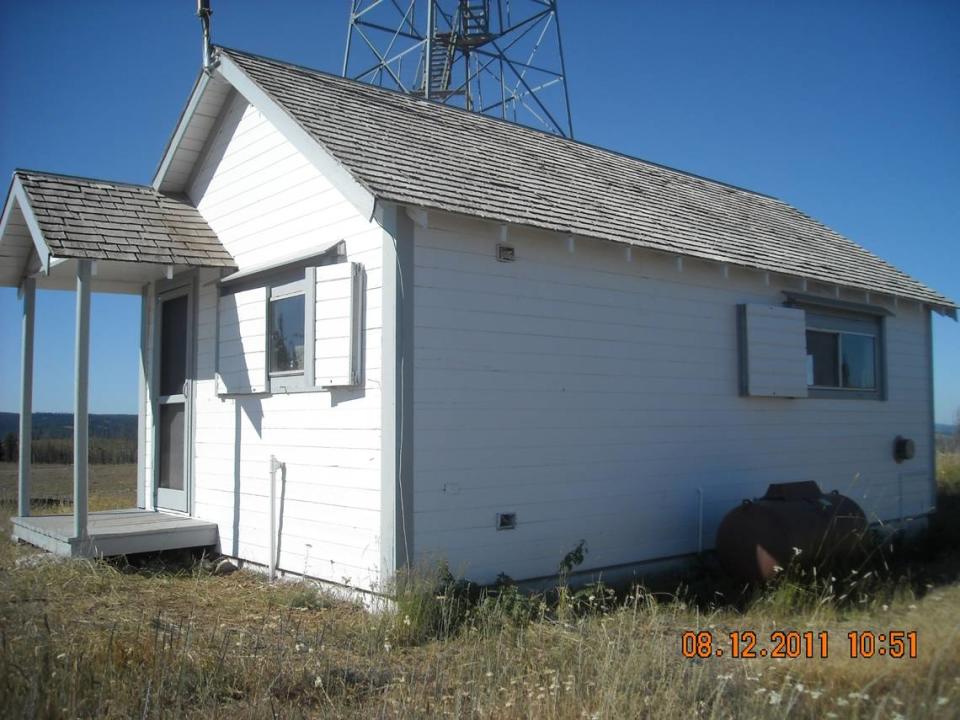
The Clearwater Lookout and Cabin is part of the Wenaha-Tucannon Wilderness near the Pomeroy and Walla Walla Ranger District. It’s a small cabin sitting 5,600 feet above sea level, according to the U.S. Forest Service, offering sights of the wilderness and the Blue Mountains. The lookout extends up from the cabin, but is off-limits. The views from just the cabin are still “uncluttered,” according to USFS.
The cabin includes four single beds and a kitchen complete with a fridge, stove and oven. There’s a nearby outhouse as well. Be sure to bring a lot of water for your stay, as there is no on-site water service. You can drive up to the cabin between June and October, but when snow is still on the ground, alternate transportation options like snowshoes or snowmobiles are required.
The Clearwater Lookout Cabin can be rented year-round for $50 a night, just be sure to call the Ranger District three business days before your visit to acquire the cabin combination. Call 509-843-1891 Monday through Friday from 7:30 a.m. to 4:30 p.m.
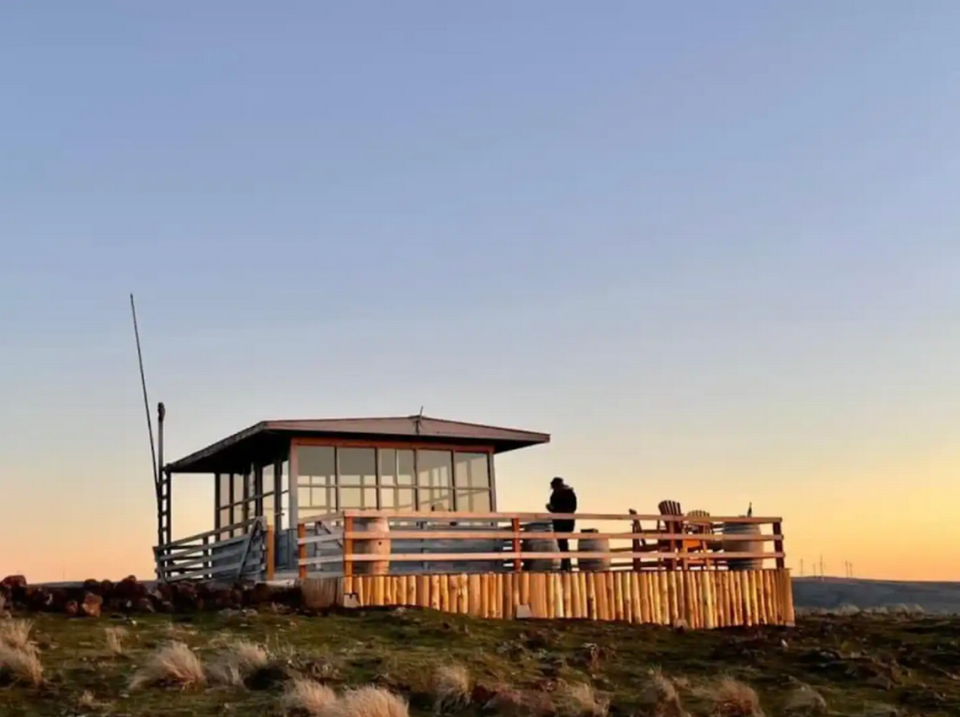
▪ Lorena Butte Lookout
Spend the night in the Lorena Butte Lookout, now on the Lefever Holbrook Ranch private property, rented on Airbnb and HipCamp. The working ranch land has views of Mount Hood, Mount St. Helens and Mount Adams.
Basic amenities are included, along with a large deck and common seating area. Pricing depends on the number of guests (two maximum) and the length of your stay. Pets are allowed with notice, dogs must be leashed when outside.
The lookout was built for use by the Department of Natural Resources, serving as a live-in looker location through 1993, according to the National Historic Lookout Register.
Operational fire lookouts near Tri-Cities
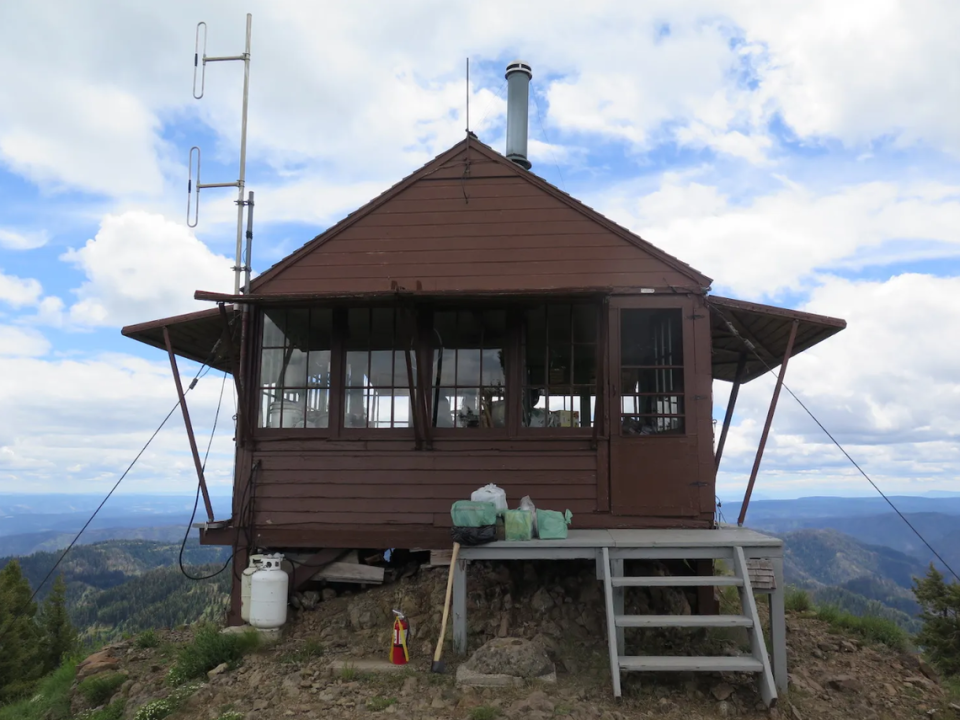
Also located in the Wenaha-Tucannon Wilderness is the Oregon Butte Lookout, a moderate six-mile hike from the Teepee Trailhead, according to the Washington Trail Association. It’s the highest peak in southeast Washington. Enjoy 360-degree views including the Wallowa Mountains at the lookouts’ 6,387 feet elevation.
The Oregon Butte area gets heavy snow in the winter, hitting the lookout first. It is sometimes staffed by lookers, so call the Pomeroy Ranger District ahead of time. Call 509-843-1891 Monday through Friday from 7:30 a.m. to 4:30 p.m.
You need to have a Northwest Forest Pass for this walking and horses-only hike. A $5 day-use fee may be accepted in lieu of a pass.
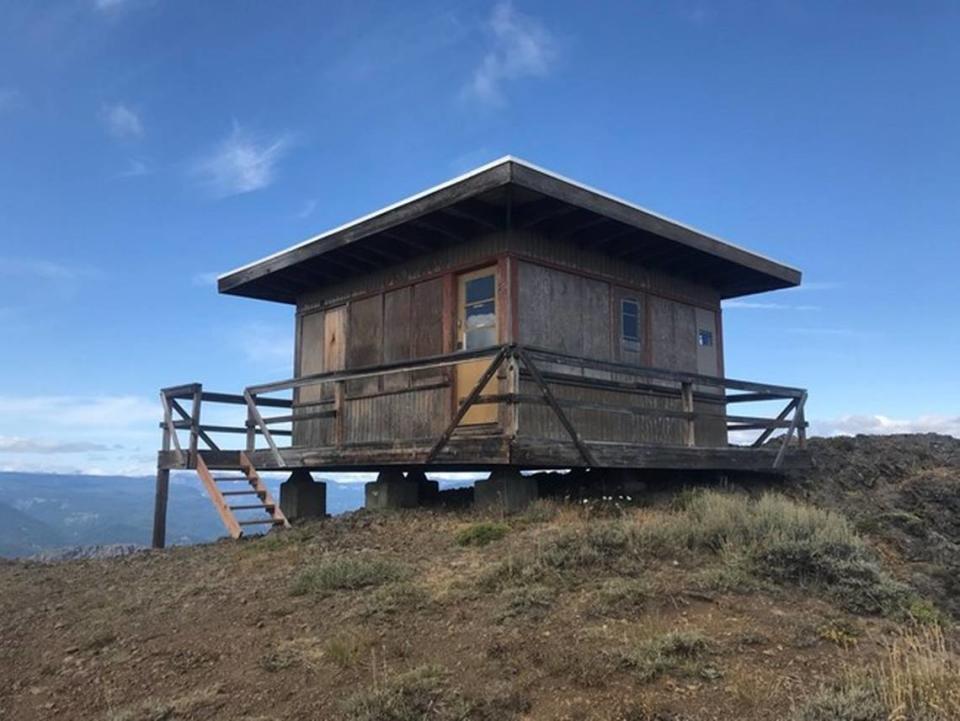
The last fire lookout remaining in the Naches Ranger District, the hike to Jumpoff Lookout is not for novices. The 10-mile round-trip trek is unsigned and challenging, but you’ll get to take in the sights of the Ponderosa pine forest, a small lake and views of Rainier. Follow this guide from the Washington Trails Association if you’re not familiar. Alternatively, you can use a high-clearance vehicle to drive there.
Spin around for views of the Goat Rocks Wilderness, Rimrock Lake, Mount Aix and Goose Egg Mountain at 5,670 feet.
The lookout is occasionally used during fire season emergencies, according to Robin DeMario with the Okanogan-Wenatchee National Forest. It is not staffed daily, but lookers may be sent out in certain scenarios. Jumpoff Lookout is one of 14 operational lookouts on the forest property, but it is the only one within the region.
DeMario confirmed that visitors can hike up to the lookout but cannot hang out inside. If there is someone on duty, they may or may not have time to chat, so be respectful of those working.
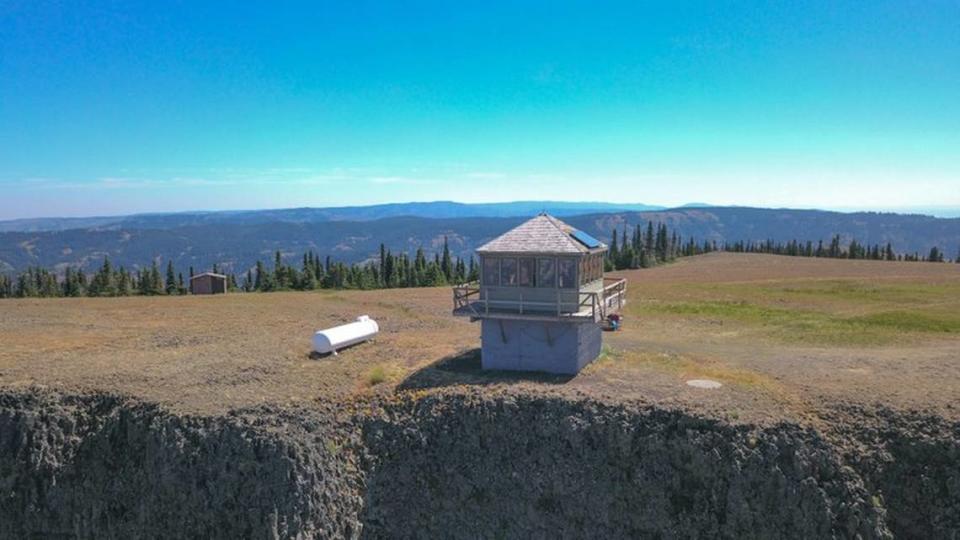
Sitting on the edge of the Mill Creek Watershed, the Table Rock Fire Lookout is staffed through fire season and open to the public from February to November. Views from the 6,250 feet elevation include Walla Walla Valley, the Wallowa Mountains and the Seven Devil Mountains of Idaho.
The hike to the lookout is not difficult, but not all vehicles can manage the drive. Check out the route provided by the Washington Trail Association before going.
Fire lookouts on Yakama Reservation
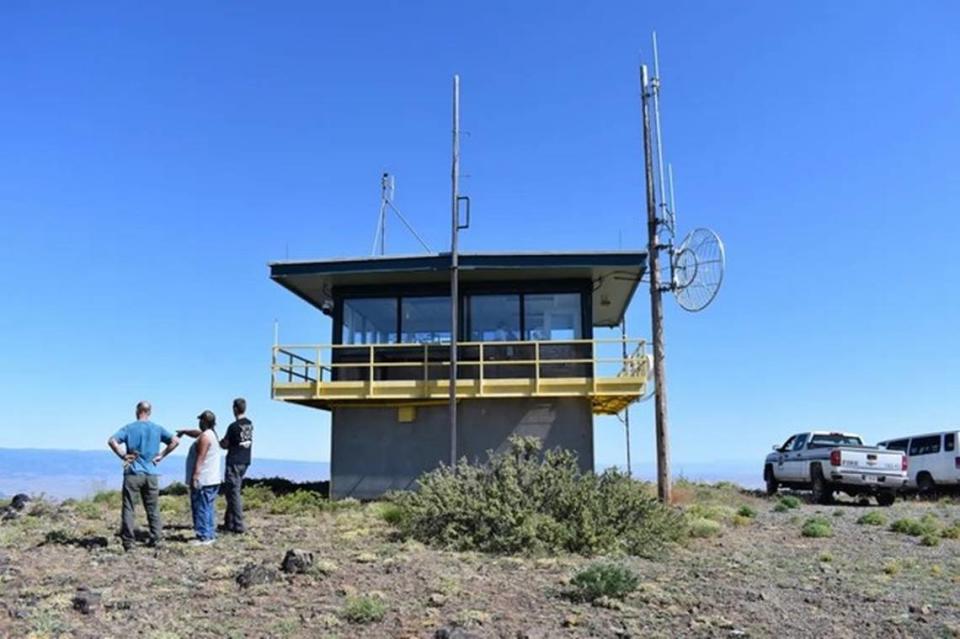
The Satus Peak Lookout on the Yakama Reservation is staffed by Yakama Nation Fire Management during fire season. The structure has been rebuilt around a dozen times since it was first built due to severe winds in the area.
Compared to the other lookout on the reservation, Satus Peak is used more often as it is equipped with electricity and can be used for overnight staffing.
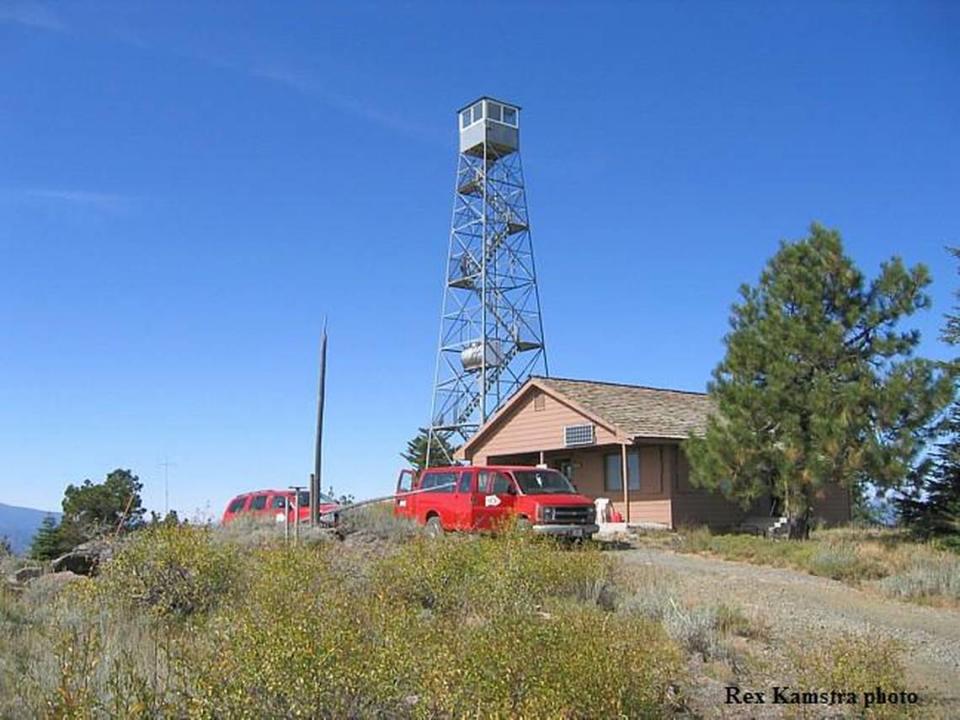
The only other lookout still standing on the Yakama Nation Reservation is the Signal Peak Lookout, a three-legged lookout with an accompanying cabin. The building isn’t in great shape, according to Brian Howell, Assistant Fire Management Officer, so it’s not used as much as Satus Peak. But it is occasionally staffed as well, and offers gorgeous green views in all directions.
Both the Satus Peak and Signal Peak Lookouts are on enclosed parts of tribal land. Tribal members can visit the lookouts and surrounding areas. Groups are occasionally granted requests for tours with fire management.
Fire season in Washington
While exploring Washington’s high peaks and enjoying the views of the fire lookout towers, you may spot what the towers were initially designed to find: smoke.
The Washington Department of Natural Resources and the State Department of Health warned earlier this month that the Evergreen State could see an active wildfire season thanks to a forecast for below-normal precipitation.
“We’re in for a long, active fire season this year that will drain resources and makes the potential of large fires impacting communities worrisome,” Commissioner of Public Lands Hilary Franz said in a news release.
Kaitlyn Kelly, an air quality specialist with the Department of Health, also warned of an active season with wildfire smoke posing a serious issue to health. Wildfires have already started popping up across the state, including two large fires; the Oasis fire in Walla Walla County and the Sutherland fire in Clallam County.
If you see a fire while hiking, Matthew Dehr, lead fire meteorologist at the Department of Natural Resources, told McClatchy News that the easiest solution is to call 911.
“From 911, they’ll dispatch it out to either the local fire protection district or the DNR Fire Protection District so that we can start dispatching firefighters to that location,” Dehr said. “It’s a very intercoordinated system. No matter where you’re at, you’re covered by some sort of fire protection, even if you’re in the remote wilderness.”
About 40% of wildfires are caused by lightning, Dehr said, but the other 60% comes from human means. While some fire-starting reasons are obvious — such as losing control of a bonfire — others are less intuitive. Dehr explained the other ways wildfires can start and how to avoid them.
Ensure no chains are dragging along the ground off a trailer when driving. Sparks generated off the chain running along the roadway can ignite dry vegetation near roadsides.
Don’t flick cigarette buds or other hot materials out of the car window or onto dry vegetation.
Don’t park a hot car above or near dry grass. The heat from the vehicle can start a fire.
If hunting or firing a gun, beware of hot bullets and pellets - the heat from them can also start a fire in the right conditions.

